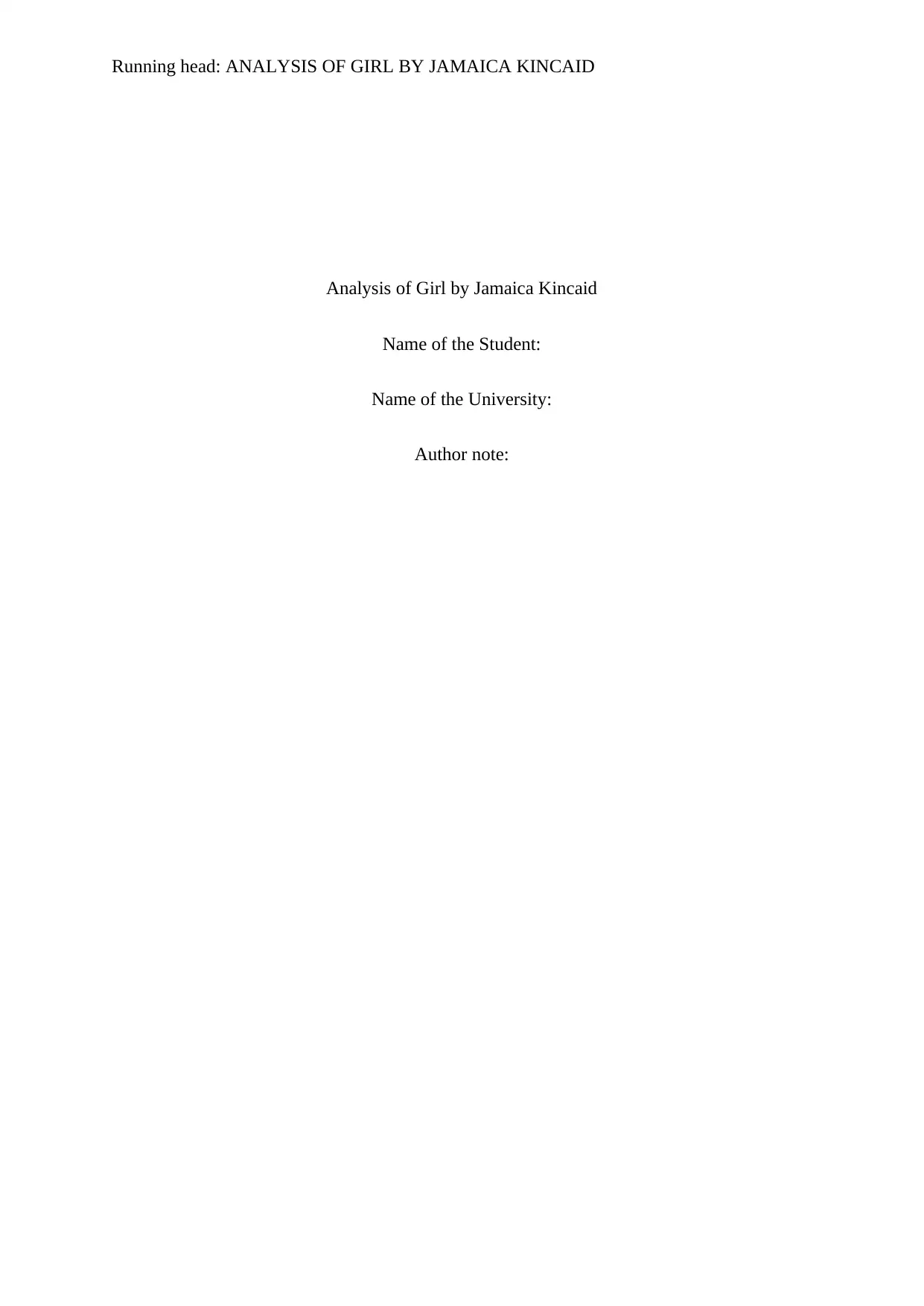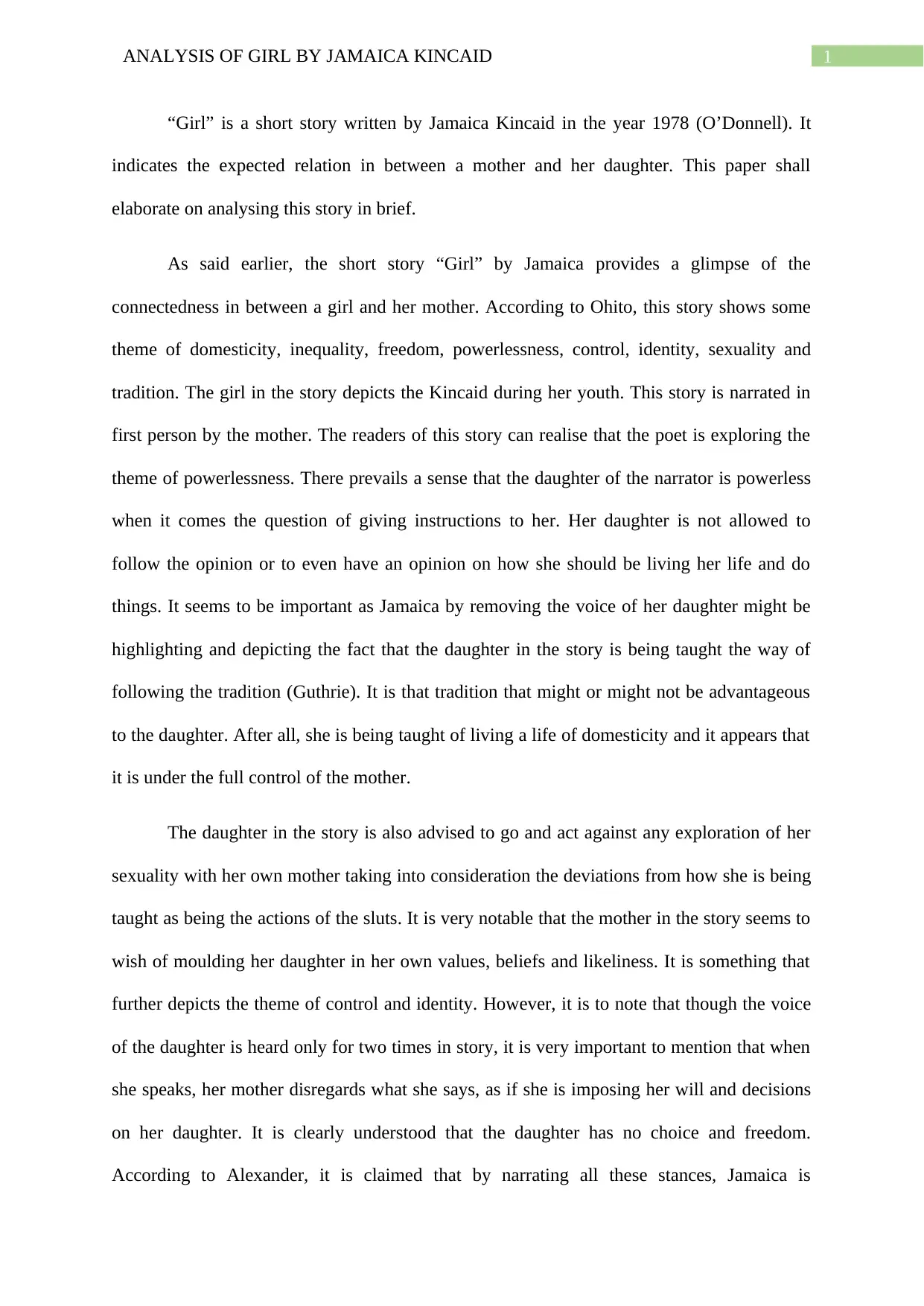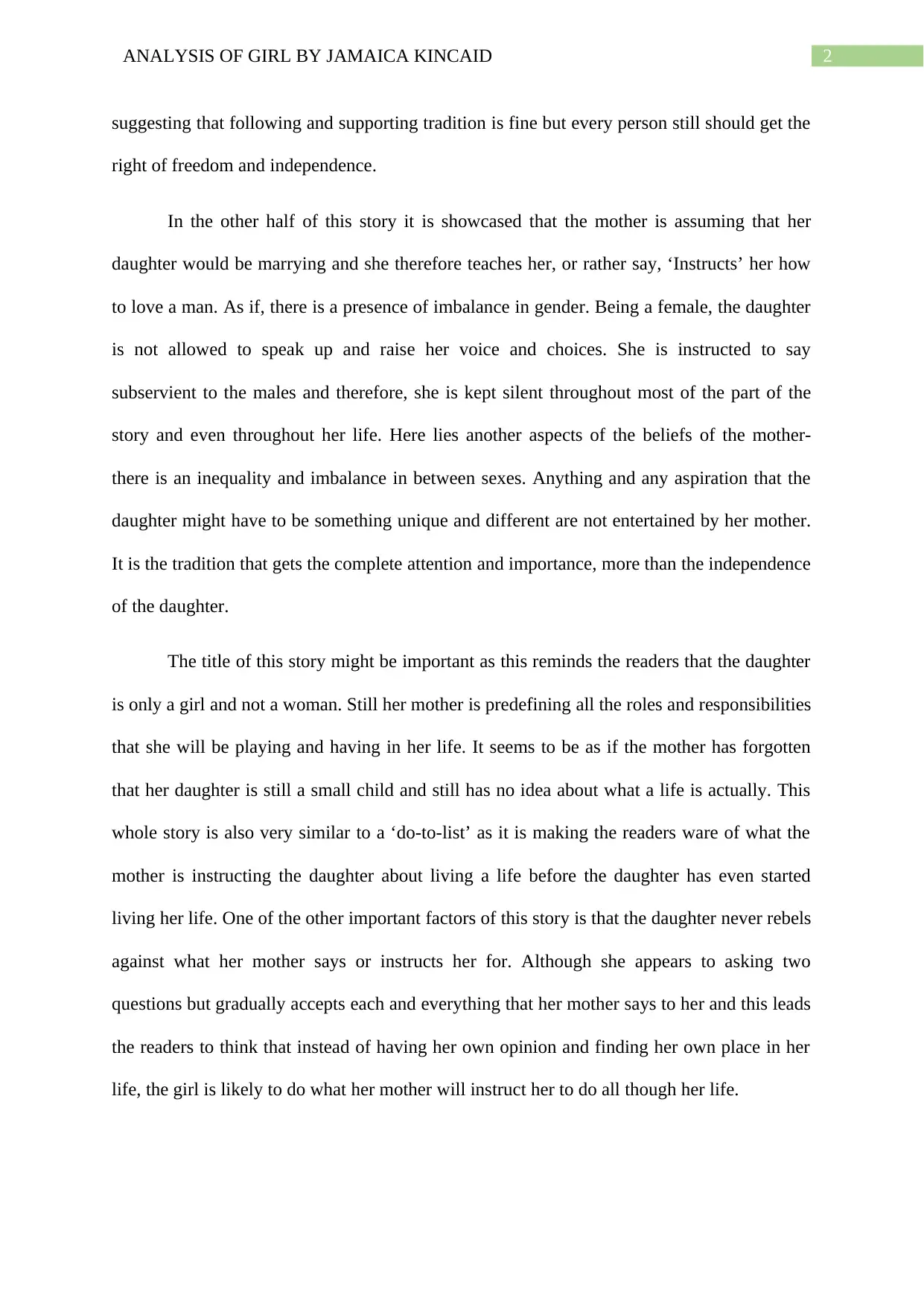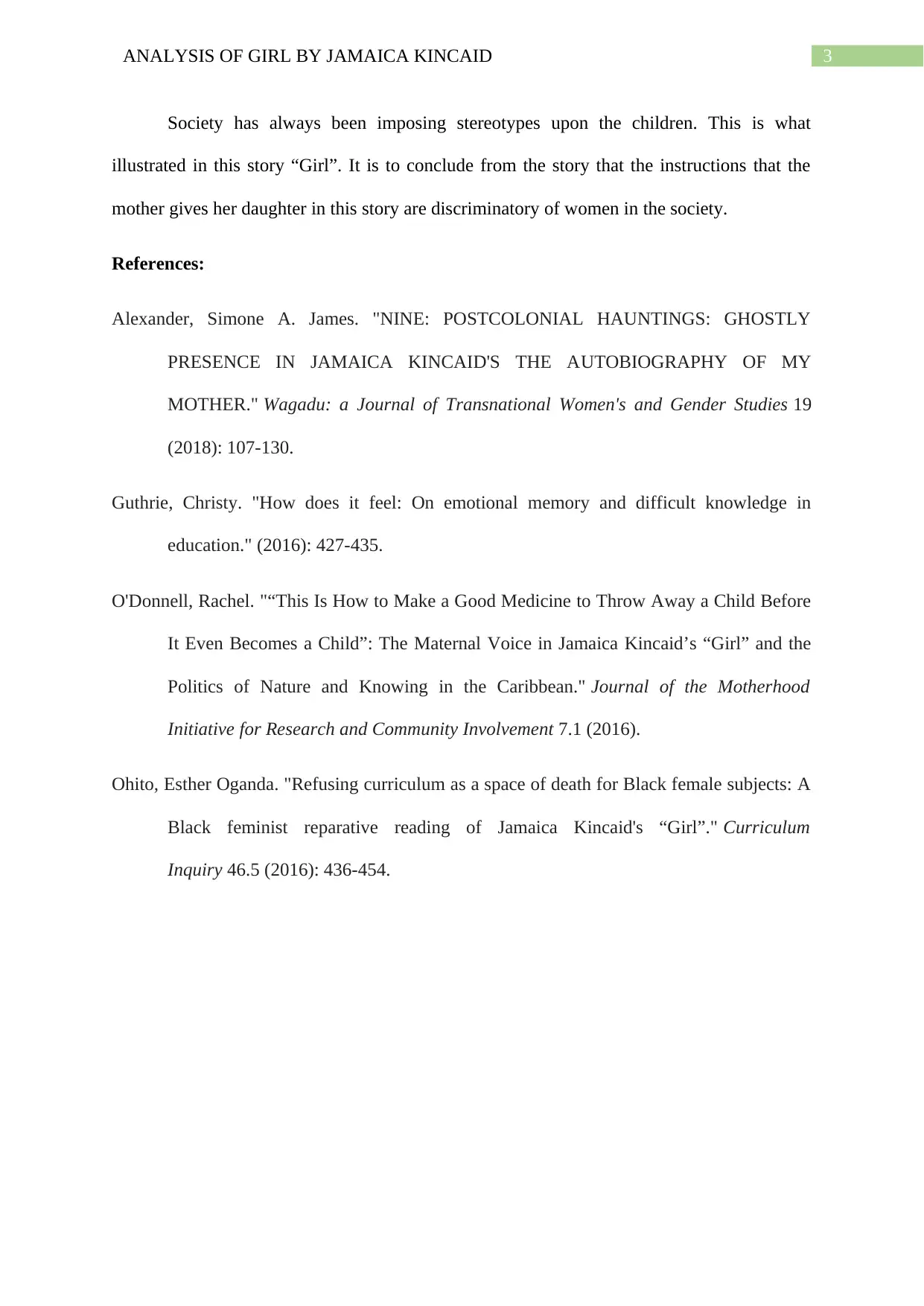Detailed Analysis of Power Dynamics in Jamaica Kincaid's 'Girl'
VerifiedAdded on 2022/12/26
|4
|1087
|1
Essay
AI Summary
This essay provides a detailed analysis of Jamaica Kincaid's short story, "Girl." It explores the complex relationship between a mother and daughter, highlighting themes of domesticity, power dynamics, inequality, control, identity, sexuality, and tradition. The essay examines the mother's instructions and expectations for her daughter, revealing the societal pressures and gender imbalances present in the story. It discusses the daughter's limited voice and agency, the imposition of traditional roles, and the mother's desire to shape her daughter's life according to her own values. The analysis draws on critical perspectives to understand the story's commentary on female identity, societal stereotypes, and the potential for freedom and independence. The essay concludes by emphasizing the discriminatory nature of the mother's instructions and their impact on the daughter's future.

Running head: ANALYSIS OF GIRL BY JAMAICA KINCAID
Analysis of Girl by Jamaica Kincaid
Name of the Student:
Name of the University:
Author note:
Analysis of Girl by Jamaica Kincaid
Name of the Student:
Name of the University:
Author note:
Paraphrase This Document
Need a fresh take? Get an instant paraphrase of this document with our AI Paraphraser

1ANALYSIS OF GIRL BY JAMAICA KINCAID
“Girl” is a short story written by Jamaica Kincaid in the year 1978 (O’Donnell). It
indicates the expected relation in between a mother and her daughter. This paper shall
elaborate on analysing this story in brief.
As said earlier, the short story “Girl” by Jamaica provides a glimpse of the
connectedness in between a girl and her mother. According to Ohito, this story shows some
theme of domesticity, inequality, freedom, powerlessness, control, identity, sexuality and
tradition. The girl in the story depicts the Kincaid during her youth. This story is narrated in
first person by the mother. The readers of this story can realise that the poet is exploring the
theme of powerlessness. There prevails a sense that the daughter of the narrator is powerless
when it comes the question of giving instructions to her. Her daughter is not allowed to
follow the opinion or to even have an opinion on how she should be living her life and do
things. It seems to be important as Jamaica by removing the voice of her daughter might be
highlighting and depicting the fact that the daughter in the story is being taught the way of
following the tradition (Guthrie). It is that tradition that might or might not be advantageous
to the daughter. After all, she is being taught of living a life of domesticity and it appears that
it is under the full control of the mother.
The daughter in the story is also advised to go and act against any exploration of her
sexuality with her own mother taking into consideration the deviations from how she is being
taught as being the actions of the sluts. It is very notable that the mother in the story seems to
wish of moulding her daughter in her own values, beliefs and likeliness. It is something that
further depicts the theme of control and identity. However, it is to note that though the voice
of the daughter is heard only for two times in story, it is very important to mention that when
she speaks, her mother disregards what she says, as if she is imposing her will and decisions
on her daughter. It is clearly understood that the daughter has no choice and freedom.
According to Alexander, it is claimed that by narrating all these stances, Jamaica is
“Girl” is a short story written by Jamaica Kincaid in the year 1978 (O’Donnell). It
indicates the expected relation in between a mother and her daughter. This paper shall
elaborate on analysing this story in brief.
As said earlier, the short story “Girl” by Jamaica provides a glimpse of the
connectedness in between a girl and her mother. According to Ohito, this story shows some
theme of domesticity, inequality, freedom, powerlessness, control, identity, sexuality and
tradition. The girl in the story depicts the Kincaid during her youth. This story is narrated in
first person by the mother. The readers of this story can realise that the poet is exploring the
theme of powerlessness. There prevails a sense that the daughter of the narrator is powerless
when it comes the question of giving instructions to her. Her daughter is not allowed to
follow the opinion or to even have an opinion on how she should be living her life and do
things. It seems to be important as Jamaica by removing the voice of her daughter might be
highlighting and depicting the fact that the daughter in the story is being taught the way of
following the tradition (Guthrie). It is that tradition that might or might not be advantageous
to the daughter. After all, she is being taught of living a life of domesticity and it appears that
it is under the full control of the mother.
The daughter in the story is also advised to go and act against any exploration of her
sexuality with her own mother taking into consideration the deviations from how she is being
taught as being the actions of the sluts. It is very notable that the mother in the story seems to
wish of moulding her daughter in her own values, beliefs and likeliness. It is something that
further depicts the theme of control and identity. However, it is to note that though the voice
of the daughter is heard only for two times in story, it is very important to mention that when
she speaks, her mother disregards what she says, as if she is imposing her will and decisions
on her daughter. It is clearly understood that the daughter has no choice and freedom.
According to Alexander, it is claimed that by narrating all these stances, Jamaica is

2ANALYSIS OF GIRL BY JAMAICA KINCAID
suggesting that following and supporting tradition is fine but every person still should get the
right of freedom and independence.
In the other half of this story it is showcased that the mother is assuming that her
daughter would be marrying and she therefore teaches her, or rather say, ‘Instructs’ her how
to love a man. As if, there is a presence of imbalance in gender. Being a female, the daughter
is not allowed to speak up and raise her voice and choices. She is instructed to say
subservient to the males and therefore, she is kept silent throughout most of the part of the
story and even throughout her life. Here lies another aspects of the beliefs of the mother-
there is an inequality and imbalance in between sexes. Anything and any aspiration that the
daughter might have to be something unique and different are not entertained by her mother.
It is the tradition that gets the complete attention and importance, more than the independence
of the daughter.
The title of this story might be important as this reminds the readers that the daughter
is only a girl and not a woman. Still her mother is predefining all the roles and responsibilities
that she will be playing and having in her life. It seems to be as if the mother has forgotten
that her daughter is still a small child and still has no idea about what a life is actually. This
whole story is also very similar to a ‘do-to-list’ as it is making the readers ware of what the
mother is instructing the daughter about living a life before the daughter has even started
living her life. One of the other important factors of this story is that the daughter never rebels
against what her mother says or instructs her for. Although she appears to asking two
questions but gradually accepts each and everything that her mother says to her and this leads
the readers to think that instead of having her own opinion and finding her own place in her
life, the girl is likely to do what her mother will instruct her to do all though her life.
suggesting that following and supporting tradition is fine but every person still should get the
right of freedom and independence.
In the other half of this story it is showcased that the mother is assuming that her
daughter would be marrying and she therefore teaches her, or rather say, ‘Instructs’ her how
to love a man. As if, there is a presence of imbalance in gender. Being a female, the daughter
is not allowed to speak up and raise her voice and choices. She is instructed to say
subservient to the males and therefore, she is kept silent throughout most of the part of the
story and even throughout her life. Here lies another aspects of the beliefs of the mother-
there is an inequality and imbalance in between sexes. Anything and any aspiration that the
daughter might have to be something unique and different are not entertained by her mother.
It is the tradition that gets the complete attention and importance, more than the independence
of the daughter.
The title of this story might be important as this reminds the readers that the daughter
is only a girl and not a woman. Still her mother is predefining all the roles and responsibilities
that she will be playing and having in her life. It seems to be as if the mother has forgotten
that her daughter is still a small child and still has no idea about what a life is actually. This
whole story is also very similar to a ‘do-to-list’ as it is making the readers ware of what the
mother is instructing the daughter about living a life before the daughter has even started
living her life. One of the other important factors of this story is that the daughter never rebels
against what her mother says or instructs her for. Although she appears to asking two
questions but gradually accepts each and everything that her mother says to her and this leads
the readers to think that instead of having her own opinion and finding her own place in her
life, the girl is likely to do what her mother will instruct her to do all though her life.
⊘ This is a preview!⊘
Do you want full access?
Subscribe today to unlock all pages.

Trusted by 1+ million students worldwide

3ANALYSIS OF GIRL BY JAMAICA KINCAID
Society has always been imposing stereotypes upon the children. This is what
illustrated in this story “Girl”. It is to conclude from the story that the instructions that the
mother gives her daughter in this story are discriminatory of women in the society.
References:
Alexander, Simone A. James. "NINE: POSTCOLONIAL HAUNTINGS: GHOSTLY
PRESENCE IN JAMAICA KINCAID'S THE AUTOBIOGRAPHY OF MY
MOTHER." Wagadu: a Journal of Transnational Women's and Gender Studies 19
(2018): 107-130.
Guthrie, Christy. "How does it feel: On emotional memory and difficult knowledge in
education." (2016): 427-435.
O'Donnell, Rachel. "“This Is How to Make a Good Medicine to Throw Away a Child Before
It Even Becomes a Child”: The Maternal Voice in Jamaica Kincaid’s “Girl” and the
Politics of Nature and Knowing in the Caribbean." Journal of the Motherhood
Initiative for Research and Community Involvement 7.1 (2016).
Ohito, Esther Oganda. "Refusing curriculum as a space of death for Black female subjects: A
Black feminist reparative reading of Jamaica Kincaid's “Girl”." Curriculum
Inquiry 46.5 (2016): 436-454.
Society has always been imposing stereotypes upon the children. This is what
illustrated in this story “Girl”. It is to conclude from the story that the instructions that the
mother gives her daughter in this story are discriminatory of women in the society.
References:
Alexander, Simone A. James. "NINE: POSTCOLONIAL HAUNTINGS: GHOSTLY
PRESENCE IN JAMAICA KINCAID'S THE AUTOBIOGRAPHY OF MY
MOTHER." Wagadu: a Journal of Transnational Women's and Gender Studies 19
(2018): 107-130.
Guthrie, Christy. "How does it feel: On emotional memory and difficult knowledge in
education." (2016): 427-435.
O'Donnell, Rachel. "“This Is How to Make a Good Medicine to Throw Away a Child Before
It Even Becomes a Child”: The Maternal Voice in Jamaica Kincaid’s “Girl” and the
Politics of Nature and Knowing in the Caribbean." Journal of the Motherhood
Initiative for Research and Community Involvement 7.1 (2016).
Ohito, Esther Oganda. "Refusing curriculum as a space of death for Black female subjects: A
Black feminist reparative reading of Jamaica Kincaid's “Girl”." Curriculum
Inquiry 46.5 (2016): 436-454.
1 out of 4
Your All-in-One AI-Powered Toolkit for Academic Success.
+13062052269
info@desklib.com
Available 24*7 on WhatsApp / Email
![[object Object]](/_next/static/media/star-bottom.7253800d.svg)
Unlock your academic potential
Copyright © 2020–2025 A2Z Services. All Rights Reserved. Developed and managed by ZUCOL.


